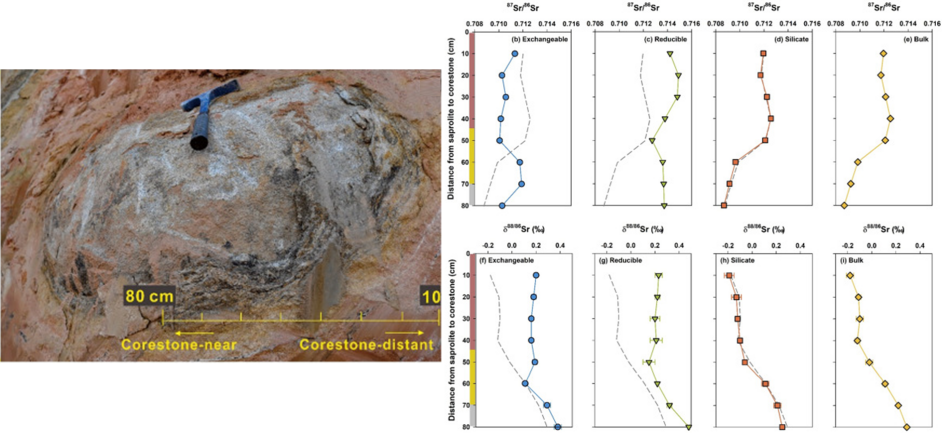二、大陆风化与气候演变:从指标记录到过程机制
Continental Weathering and Climate Evolution: from Proxy Records to Mechanisms
硅酸盐岩风化可以消耗大气CO2,是重要碳汇,也是维持地球长期气候宜居性的关键机制。2022年,我室“大陆边缘沉积学”团队围绕“亚洲大陆风化剥蚀与碳循环过程如何调控晚新生代气候变化”这一重大科学问题,开展不同时空尺度的大陆风化过程、风化指标及其环境效应研究,为进一步深化大陆风化与气候演变研究提供了坚实基础。
大陆硅酸盐风化程度的温度控制
硅酸盐风化过程如何响应并调控地球气候,以及气候-风化反馈强度如何随时间变化,一直以来是学界关注的热点问题,但至今未有定论。
针对这一问题,Deng et al. (2022) 搜集了全球河流细粒沉积物的主量元素数据(n=3828)以计算风化程度指标化学蚀变指数(CIA),并进一步提取相应流域的各类环境因子进行对比,从而能够解析硅酸盐风化程度的主控因素及其地质意义。研究发现,在大陆尺度上,硅酸盐矿物的风化强度主要受控于地表温度,而降水以及地形-岩性等参数的控制仅处于次要地位。此外,温度对硅酸盐风化的主要过程之一,即长石类矿物的水解(由CIA约束),具有非线性的控制作用:随着温度升高,长石水解过程对于温度的响应逐渐减弱。
地表温度与硅酸盐风化程度间的内在联系具有显著的地质意义。一方面,该研究基于大量数据提出了沉积物硅酸盐风化程度指标与地表气温的经验关系式(ΔMAT/ΔCIA ≈ 1),并能够合理地重建地质历史时期中气候冷/暖事件中的古气温变化。更为重要的是,在全球尺度上,长石类矿物风化过程对于温度变化的非线性响应,暗示着地表的风化反馈强度在地质历史中可能也存在变化:在新生代全球变冷的大格局下,风化反馈强度可能逐渐升高,从而更有能力维持百万年尺度上的气候稳定性。

河流沉积物化学蚀变指数(CIA)的全球分布图
晚新生代以来东亚大陆硅酸盐风化对气候的差异响应
在现代硅酸盐风化过程的研究基础上,Li et al. (2022) 进一步研究了东亚晚新生代以来的风化记录。在东亚陆缘和东南亚区域,沿纬度断面选取了12个站位,得到4 Ma以来的风化指标(CIA)记录。经过指标校正分析,获得各个站位及不同地区的标准化风化强度记录。结合古气候(海表温度,即SST距平)资料,建立地质时期不同区域风化强度与温度的定量关系。
结果显示,时间上,风化强度自上新世以来逐渐降低;空间上,风化强度自北向南逐渐增强。上新世—第四纪期间,东南亚的风化强度对温度变化的响应为0.8 CIA/℃左右,与团队的现代过程研究一致,而东亚陆缘的风化对气候变冷的响应更加敏感。基于东亚不同区域的物源记录,Li et al. (2022)进一步发现这一时期东亚陆缘的沉积物源区扩大、溯源侵蚀加强,推测是造成风化强度显著降低的重要因素。总而言之,该研究系统评估了不同区域的硅酸盐风化强度对温度的差异响应,为晚新生代变冷的大陆风化反馈研究提供了新视角。


上新世—第四纪期间东南亚、东亚钻孔记录中硅酸盐风化强度对温度的响应
Sr稳定同位素示踪硅酸盐风化过程的机制研究
地表风化系统中Sr稳定同位素(δ88/86Sr)的变化可以帮助理解流体相和固相之间Sr元素结合形式的转变。然而,化学风化过程中Sr稳定同位素分馏机制的研究仍然很有限。
Su et al., (2022) 针对我国东南花岗闪长岩球状风化剖面,系统研究了Sr同位素在花岗闪长岩风化过程中的行为。在剖面风化强度初步增加时,母岩附近的风化土/腐泥土中87Sr /86Sr增加,δ88/86Sr却下降。随着风化程度进一步增强,高岭石大幅增加,风化土中87Sr /86Sr和δ88/86Sr值却稳定。化学相态分析表明硅酸盐组分主导了母岩和风化土中的Sr同位素组成。矿物的差异风化是导致风化早期Sr稳定同位素组成变化的主要原因,而随着风化程度加强,次生黏土矿物增多,86Sr优先进入次生矿物的晶格内,导致风化产物Sr稳定同位素组成持续偏轻。结合对比经典的化学风化指数(如CDF和CIA),研究认为Sr稳定同位素可以成为研究硅酸盐风化强度的一个潜在替代指标。

母岩球状风化剖面(左)及其δ88/86Sr(右上)、δ88/86Sr(右下)分布
主要参考文献:
Deng, K., Yang, S., Guo, Y., 2022. A global temperature control of silicate weathering intensity. Nature Communications, 13: 1781.
Li, F., Yang, S., Breecker, D.O., Ramos, E.J., Huang, X., Duan, Z., Guo, Y., Li, C., Mei, X., 2022. Responses of silicate weathering intensity to the Pliocene-Quaternary cooling in East and Southeast Asia. Earth and Planetary Science Letters, 578: 117301.
Su, N., Wu, Z., Yang, S., Xu, J., 2022. Re-assessing the effect of differential weathering of minerals on strontium stable isotope behavior during granodiorite weathering. Chemical Geology, 613: 121160.
Chemical weathering of silicate minerals plays a key role in maintaining the long-term habitability of Earth’s climate over geological timescales via a negative feedback mechanism, but much current debate concerns its response to various climatic factors and its evolution with land surface reorganization. To tackle this key scientific question, the research group of Continental Margin Studies led by Prof. Shouye Yang worked on the continental weathering processes, weathering proxies and their environmental implications.
In 2022, the catchment-scale linkage of silicate weathering intensity with various environmental parameters was examined using a global compilation of modern sediment dataset (Deng et al., 2022). The results showed a primary control of temperature on silicate weathering given the monotonic increase of feldspar dissolution with it, while controls of precipitation or topographic-lithological factors are regional and subordinate. The non-linear forcing of temperature on feldspar dissolution was interpreted as a depletion of more reactive plagioclase at higher temperature. The results hint at stronger temperature-weathering feedback at lower surface temperature and support the hypothesis of increased land surface reactivity during the late Cenozoic cooling.
In addition, to clarify the climate dependence of weathering in the late Cenozoic, 4 Myr weathering intensity records determined by Chemical Index of Alteration (CIA), are compiled from 12 sites along the East and Southeast Asian margins (Li et al., 2022). All the CIA records show overall decreasing trends, corresponding to the global cooling since 4 Ma. The correlation analyses indicate a temperature sensitivity of stacked CIA record in Southeast Asia, that is consistent with modern observations. In comparison, the temperature sensitivity of weathering intensity is higher in East Asia, which may be related to dynamic source-to-sink processes and weathering regime changes, as evidenced by a strontium isotopic study on a weathering profile of granodiorite in southeast China (Su et al., 2022). To sum up, our findings provide new insights on the mechanisms of continental weathering and their linkage to the late Cenozoic global cooling.

